Overlooking a Best Friend's Flaws: The Olympus E-P3
"There is just something about the little Oly that gets me. If a Leica talks to my soul, the PEN talks to my heart." -- Steve Huff (stevehuffphoto.com)
A best friend is a choice based on many things, and like people no camera is perfect. A camera is to some extent the sum of its parts -- but one of those parts is YOU.
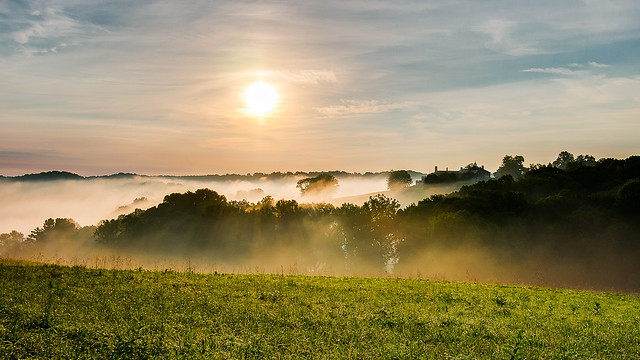
Sunrise Over the Brandywine Valley
(E-P3 with Panasonic 20m F/1.7 lens)
Originally published February, 2013.
The shot above was taken with an Olympus E-P3 in 5 shot, 1 stop exposure bracket mode. Three exposures were then selected -- the center, brightest, and darkest -- and run through Enfuse for Lightroom to create the HDR shot you see above.
My E-P3 takes the shots in the order: normal, -2, -1, +1, +2 so the "middle" shot is actually the first one taken.
There are two of my previous ramblings that relate to this post. One is Photographers and Their Machines: Love Affair, Crutch, or Prosthesis? which is about how the cameras we love are about something which can't quite be measured. The other one is EVIL Intentions: Living in the Land of MILC and Honey -- which is really part one of this two part article.
When I wrote the last post a couple of months ago, I was very happy with what my E-P2 was capturing, but I became disenchanted with the severe limitations of the autofocus system in some situations. Finally, I went and got a refurbished E-P3 (twice what the used E-P2 cost) and sold both the E-PL1 and the E-P2. You might want to consider avoiding my mistake and buying the latest E-PL3, E-PM1, or E-P3 with the faster autofocus technology and avoid all the trouble of trying to be too cheap!
Here's another shot I took with the E-P3 -- a conventional exposure -- that I took recently in the town where I live.

The Road Less Traveled: Door #4
(E-P3 with Panasonic 20m F/1.7 lens)
I quoted Steve Huff in my introduction and he has a photography site I love to read. He's a shooter: he doesn't spend time with scientific tests and the minutiae that photography forum people spend endless hours arguing about. He takes pictures and speaks of how it was to use the camera, and shows you the images he took. Like him, I've found the Olympus E-P3 to be an all-time favorite camera based on really using it. It makes me smile and so do the photos I get.
What makes the E-P3 So Special
First: it's small and doesn't stand out as a "pro camera".
In my previous blog post, I spoke of the need for a smaller, lighter, less obtrusive camera with which to shoot. My DSLR's are wonderful, flexible, and capable of incredible quality. They are also heavy and intimidating to many subjects. It is reminiscent of Werner Heisenberg's "Uncertainty Principle" or Schroedinger's "Cat" parable -- both of which imply that you can't observe something without affecting it in some way. A smaller camera generally has less effect.

Kennett Carnival: C'mon Daddy!
(E-P3 with Panasonic 14mm F/2.5 lens)
The shot above encapsulates exactly the sort of thing I want when I do "street photography" -- a genre I am woefully inexperienced in. Everyone in the shot has no idea that they are being photographed and so are "being themselves". The camera is small and no one notices it and here it is even hanging down at my side and I'm shooting blind not even looking in the direction of my subjects! I'm invisible... [cue spooky music]
Here's another one using the "I'm just standing here, I'm not taking pictures" technique. The staff of this carnival "acted" whenever you pointed the camera at them. I know they probably think they are being theatrical and helping out -- but I wanted some candids. This guy thought I was looking over where he was looking.
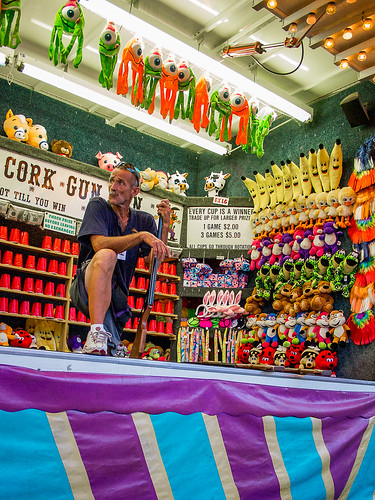
Kennett Carnival: The Arms Dealer
(Olympus E-P3 with Panasonic 14mm f/2.5 lens)
Second: it autofocuses as FAST as a DSLR
But not in all circumstances, unfortunately. If your subject is moving too quickly, it can't "track" focus as well as a good DSLR. See my previous post for a little bit of background on the autofocus technology difference between the two systems. I can still chase grand-kids around with the E-P3 and it is MUCH better than any previous Olympus PEN cameras; but if you're a sports shooter using autofocus to track moving players until the exact instance to shoot -- you're likely going to be disappointed.

Kennett Carnival: Hair Raising Ride
(E-P3 with Olympus 45mm F/1.8 lens)
The shot above could be hard to nail for some contrast detection autofocus systems. The system is going to want to focus on the brightest objects which are the people on the ride -- but the ride is moving. The E-P3 did not struggle at all with this shot, focusing and shooting in a small fraction of a second when I asked it. It "feels" like a DSLR in this way -- it is very responsive and fast both in terms of focus time and shutter lag.
Third: Great Selection of Lenses
So far, the shots above have featured three of the best prime lenses for the micro four thirds cameras (that is, they work on both Olympus and Panasonic bodies). Those lenses are:
- Olympus 45mm f/1.8 -- one of the best lenses I've ever used. With a fast (in terms of what shutter speeds it permits) f/1.8 aperture and a full frame equivalent focal length of 90mm, it is a great lens for portraiture or anywhere a short telephoto is called for. The bokeh (quality of background blur) of this lens is just outstanding. The blur is smooth and creamy and the lens is simply stunningly sharp "wide open" (at f/1.8). The totally silent autofocus is about as fast as it gets and works hand-in-hand with the E-P3's fast autofocus system. It's available for under $350 and that makes it one of the best bargains in super high quality lenses.
- Panasonic 20mm f/1.7 -- the "granddaddy" of the great primes made for micro four thirds cameras. This lens is not as fast or quiet in autofocus as the Olympus 45mm, but it is gifted with the same great sharpness wide open and produces stunning photos. Some say its actual focal length is closer to 18mm than 20mm, so depending on who you believe its equivalent full frame focal length is 36 to 40mm -- making it a fast "standard" or perhaps a slightly wide angle lens. Well under $400 used and sometimes new.
- Panasonic 14mm f/2.5 -- Although not as fast an aperture as the other two above, it's still better than any of the "kit" lenses. Equivalent to 28mm on full frame, it's wide enough to be useful, but not as wide as I'd like for some things. But like any really good prime, it's very sharp wide open and the autofocus is fast and fairly quiet. On top of that it is a VERY tiny pancake lens that makes the E-P3 about as small as it can be. Less than $300 (and you can find it under $200) and very available both used and new.
The Olympus 45mm just amazes me. Look at this wide open shot on the street at night of a street musician. Look at the sharpness and I might add that it was shot at ISO 1600!
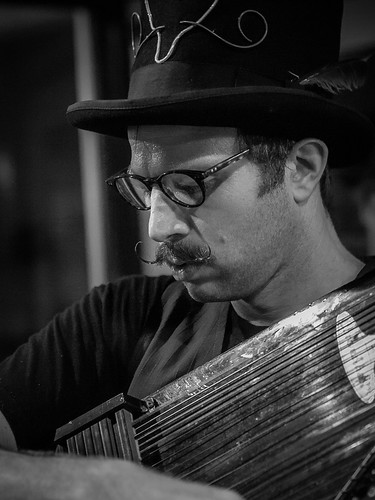
After the Show: I am love
(Olympus E-P3 with Olympus 45mm F/1.8 lens)
Another great lens is the Olympus 40-150mm F/4-5.6 ED MSC lens. This one is the equivalent of an 80-300mm lens on a full frame camera and it focuses quickly and quietly. The sharpness may not be "prime" quality like the lenses above, but it is GREAT for a zoom lens and at a price point under $200 new (discounted or refurbished) it is a STEAL.
Here is a shot using the 40-150mm on the E-P3. This shot is cropped, yet retains amazing sharpness and great bokeh. Unbelievable for such an affordable lens.

Polka Dot Eyes
(Olympus E-P3 with Olympus 40-150mm f/4-5.6 ED MSC lens)
There are more great lenses from both Panasonic and Olympus, but few are as affordable as the lenses mentioned above.
Fourth: In-Body-Image-Stablization (IBIS)
Most cameras feature some kind of image stabilizer. It can either be built into the lens or built into the camera. There is a "digital image stabilization" system in some cameras that has no moving parts -- but it works by reducing the resolution and using the middle of the sensor the the image, then it shifts where it takes the image from on the sensor in response to camera movement. It's for the most part bogus. Many video cameras work this way.
The "big boys" like Nikon, Canon, and Pentax chose lens-based stabilizers and they work very well. Pentax, Olympus and Sony (in Sony's DSLR's anyway) have chosen in-body stabilizers which work well also. Weirdly, Sony's MILC/EVIL cameras use lens based stabilizers which make their already disproportionately large lenses even bigger. Mostly Sony's lenses are so-so which is yet another reason I abandoned that platform.
I'll leave the debate about which stabilizer type is better to those with more time for useless arguments -- but I use both and like both. On my pro level Nikon gear (like my $2500 70-200mm F/2.8 VR II lens) the in-lens stabilizer is outstanding and I know I can trust this gear with critical missions. On my Olympus, it's building my faith but it has one great advantage: it works with ANY lens.
It works automatically with electronically connected lenses -- but by dialing in the focal length (in a menu entry) you can stabilize even old manual focus lenses! This is the essential virtue of IBIS over lens-based stabilization. Since you can adapt almost any lens to the typical EVIL/MILC camera with inexpensive adapters, this is a killer feature.
Here's a handheld shot using the Olympus 45mm in dark conditions.
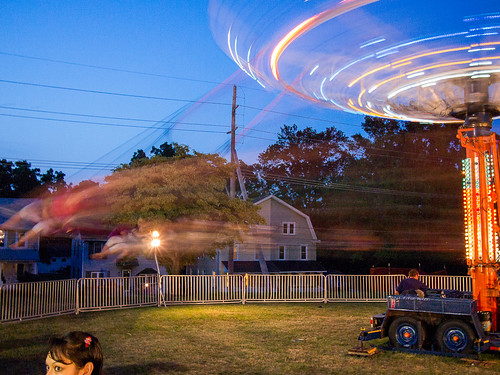
Kennett Carnival: Whoosh!
(Olympus E-P3 with Panasonic 20mm f/1.7 lens)
The shot above is a 0.5 second -- a HALF SECOND -- exposure on a 90mm equivalent lens! As remarkable as the stabilizer being able to keep the shot from blurring in the stationary parts is, also look at the fact that the woman in the lower left and the ride operator held relatively still -- enhancing the effect of this shot.
Here are a some more handheld shots showing the excellent action of the stabilizer on long exposure hand-held shots.
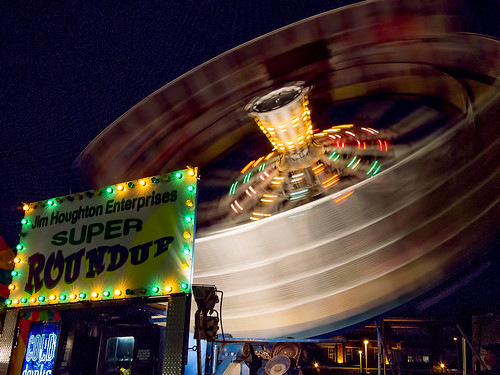
Kennett Carnival: The Super Roundup Night of Terror
(Olympus E-P3 with Panasonic 20mm F/1.7 lens)
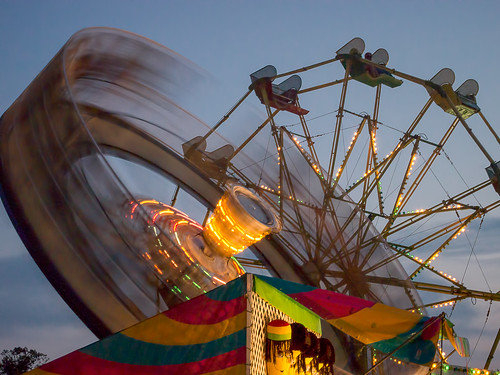
Kennett Carnival: Wheels Within Wheels
(Olympus E-P3 and Panasonic 20mm f/1.7 lens)
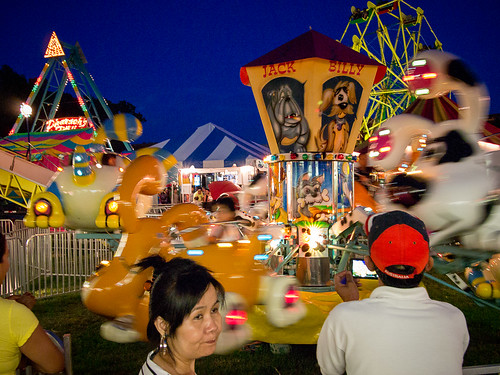
Kennett Carnival: Exhausted by Billy and Jack
(Olympus E-P3 and Panasonic 20mm f/1.7 lens)
The last shot above makes two points: one is about the stealth aspect -- shooting a small camera over my head in the general direction of a ride, the woman had no idea she was part of the photograph; the other point is once again about the action of the stabilizer.
I have to say I am thrilled with shots I was able to get with this camera and the various lenses during the hustle and bustle of a busy carnival!
Fifth: Great Handling
You can look up some of the many comprehensive reviews of the Olympus E-P3 to see what the experts have to say. Some say the layout works, others point out problems with it. I say it not only works but makes it possible to change things up quickly. But cameras are like clerics, bartenders, doctors and psychotherapists -- one size does not fit all so you need to find what works for you.
It has two control wheels like a DSLR though they're laid out differently. You can assign what each one does. For instance, when I'm shooting aperture priority mode the top wheel is aperture control, the lower one is exposure compensation. When I'm using the clip on electronic viewfinder (called the VF-2 preferred by me or the newer VF-3) I can change settings without removing the camera from my eye or dialing up some menu. Many of the buttons can also be reassigned in terms of their function a well.
For instance, Well after dark I had the camera stopped down for a shot of something really bright, when I turned around and saw this lady with her sons (or grandsons for all I know) encouraging them as they played a game. She turned and saw me shooting her and smiled, but only for a second. If I'd been fumbling to reset the aperture I'd have missed this one.
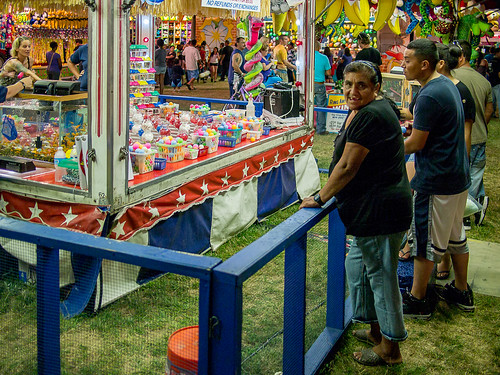
Kennett Carnival: Winning One for Ma-Ma
(Olympus E-P3 with Panasonic 20mm F/1.7 lens)
The OLED Touchscreen
One final thing I haven't mentioned: the LED touchscreen. The technology used to make the screen on the back of the camera is "Organic Light Emitting Diode" technology -- it is NOT an LCD screen. It is very bright and has a glass topped capacitive touchscreen on the top. OLED technology is not terribly new, but it has only become practical in an economical sense recently.
The OLED is different. It's power drain is directly proportional to the brightness of the image you are viewing on it, NOT on the backlight brightness because there is no backlight. Each pixel on the screen is a tiny LED light. The screen is gorgeous. It dims more often to save power but comes back up instantly. Overall, it has little impact on operation other than to seem brighter in some situations.
The touchscreen is a different matter -- and something to consider carefully. I have to admit I considered it a gimmick when I got the camera and I immediately turned the touchscreen off. Later, I read some commentary by some real photographers saying how great it was for "grab shots" (where you raise the camera and fire quickly) and I turned it back on. WOW!
Check out this shot.
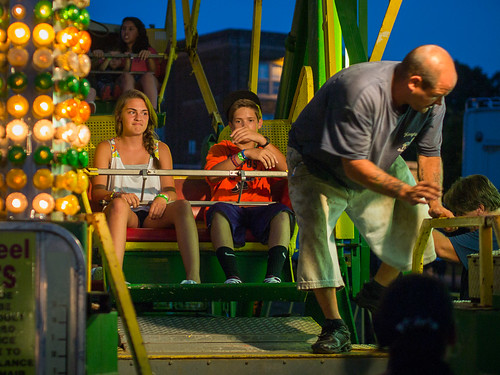
Kennett Carnival: Don't Even Think About Trying to Kiss Me
(Olympus E-P3 with Olympus 45mm F/1.8 lens)
Consider the shot above: shooting a long, fast lens you're not going to have great depth of focus, so you want to nail the focus. Normally, you raise the camera, select a focus point, then focus/shoot. Selecting the focus point takes significant time, and letting the camera choose it has significant risk: the camera has no idea what your subject is and it might focus on the operator's bald head.
The result: you might miss the shot. Now with a DSLR you'd have a point already selected, swing the camera to put over the girls face, 1/2 press to focus, and the reframe and shoot -- a faster process. You might get the shot. You can do the same with the E-P3 but it's still not the FASTEST way to do it.
The E-P3's touch screen can be used to select a focus point and shoot with one touch. In this case, I raised the camera to frame the shot and touched the girls face on the screen with my thumb. The E-P3 focused on her face and shot -- in absolute minimum time.
Other camera's have this feature, but few to none of them have the E-P3's focus speed and low shutter lag. The result is that I got a "Norman Rockwell" moment that I might have missed otherwise. What I thought was a "gimmick" is actually a great feature!
Summing Up
Alright, here's what I think encapsulates what the reasons are to have a decent mirrorless camera to carry around.
- Small and unintimidating (relatively) to subjects
- Great image quality equal to or at least close to DSLR's
- Some have an excellent array of lenses (like the Panasonic/Olympus axis)
- Can be carried and used almost anywhere (DSLR's are not allowed in some venues) -- encourages carrying a camera wherever you go
- Latest models focus fast and handle difficult light situations well
- Very fun to use -- lightweight and quick in the hand and a decent kit of lenses takes up very little space (except for Sony generally)
Here are some reasons to prefer a DSLR.
- You will look "important" and "professional" if you carry a DSLR (I know that is important to some of you, c'mon -- admit it)
- The better brands are seasoned technologies that are rugged and proven
- Autofocus systems, although not much faster anymore, are far more advanced in dynamic tracking situations
- The major systems have more options for lenses from both the manufacture and third parties. None of the MILC/EVIL systems yet come close, although the competition between Panasonic and Olympus for the same business has driven quality up and helped keep prices down.
- If you carry a full kit of lenses, you will be more fit from toting the extra weight everywhere.
If you are absolutely so detail critical you can't stand the idea of not having the very best with you at all times, buy a Leica... just kidding. What I was going to say is that if you are obsessed this way you maybe should stick with DSLR's -- but you'll miss shooting opportunities you won't get lugging the big iron around. Ideally, one has a DSLR for critical work and a mirrorless camera of some sort for carrying everywhere to get those shots that just suddenly appear.
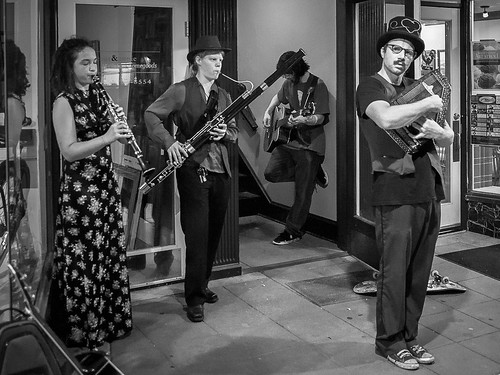
After the Show: I am love
(Olympus E-P3 and Panasonic 20mm f/1.7 lens)
The shot above was a sudden opportunity. This young and unique band was playing on the street and making a video as I came out of the opening of my "Nature" photography show in Kennett Square. I had a small camera bag (very small) with a few prime lenses and my E-P3 so I was able to get these guys quickly. If I'd had to go home or even to my car for the camera I would have missed this opportunity.
I think that's enough on this subject. If you go back to my contact page on my photography website you'll find an email address by which you can contact me if you have a question I haven't answered.
Happy Shooting!
No photographer is as good as the simplest camera. -- Edward Steichen
There is only you and your camera. The limitations in your photography are in yourself, for what we see is what we are. -- Ernst Haas
|